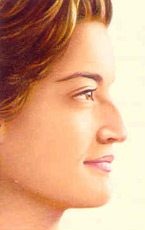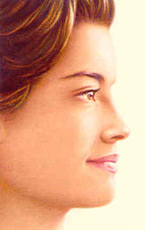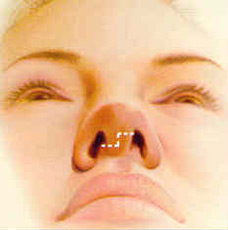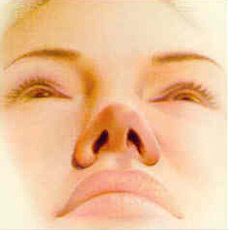Facial Rejuvenation
Rhinoplasty
Rhinoplasty, or nose shaping, is a procedure designed to improve the shape and contour of the nose. Some of the most common aesthetic goals include making the nose straighter, removing a hump from the top surface, and making the tip smaller. There are many different things that can be done to aesthetically refine a nose’s shape, and so the exact surgical procedure is determined largely upon what one’s desires are. (Figures 1 and 2)

Figure 1

Figure 2
Because the nose is an organ that is important in breathing, structural changes to the nose can affect the way that we breathe, and thus it is sometimes necessary to work on the inside of the nose as well. One of the most common procedures that is performed in conjunction with a rhinoplasty is a septoplasty. A septoplasty helps to insure that the nasal passages remain adequately open to allow air to pass freely through. Along with a septoplasty, various other maneuvers may be performed, such as removing internal obstructive structures or increasing the size of the nasal passage. All of these steps may be performed in conjunction with a rhinoplasty, depending upon one’s anatomy.
A rhinoplasty can be performed incisions that are completely internal. This is called a closed rhinoplasty. Increasingly today, modern rhinoplasty is being performed with a small incision located at the base of the nose. (Figures 3 and 4) This is known as an open rhinoplasty. Dr. Chang performs the majority of her rhinoplasties through the open approach as it allows a greater degree of precision and control over the aesthetic outcome.

Figure 3

Figure 4
In order to perform a complete rhinoplasty, first the incisions are made. Through these incisions, the bone and cartilage structure of the nose is exposed. Adjustments the shape, size, and configuration of the bony and cartilaginous elements inside the nose are made. This is performed through a combination of trimming, suturing, and grafting. Once the basic shape is achieved, depending upon the circumstance, the internal structures of the nose may be worked on, and often the two main larger nasal bones are repositioned in order to achieve a smooth aesthetic contour. Once all of these steps are completed, the skin is redraped over the cartilaginous and bony internal structure, and the final nasal shape emerges. An external splint is applied, and often internal nasal packing as well, in order to protect and set the nose. Not all patients need all of these steps. Your particular needs will be carefully assessed by Dr. Chang during you consultation, and a customized plan will be developed for you.
Rhinoplasty is performed in the hospital, under a general anesthetic. The procedure lasts between 2 and 4 hours depending upon the circumstances, and the patient may go home from the hospital the same day with supervision. The packing is removed in a few days, and the splint in a week. Initial recovery lasts approximately one week, and Dr. Chang recommends that you take this time off work. Exercise and strenuous activity may be resumed at 3 weeks, but one should take care not to engage in activities that may bump the nose for at least 6 weeks. The final shape takes nine months to a year to achieve, as the nose will settle gradually over this time period. Any revisions which may need to be performed should not be contemplated until the full healing time has elapsed.
Like any procedure, rhinoplasty surgery has some associated risks. Rhinoplasty is a unique operation in that it involves shaping an internal structure and then relies on the skin to drape back over the area to create the final outcome. Differential skin thicknesses and irregularities in internal scarring can all affect the outcome, and thus rhinoplasty does carry with it a slight higher revision rate than most other procedures. Luckily, however, these revisions are still relatively uncommon, and in the majority of cases minor. Other risks of the procedure include changes in breathing patterns, sensory changes, internal mucosal irregularities, numbness, changes in nasal drainage patterns, unfavorable scarring, bleeding, infection, and anesthetic complications.
Rhinoplasty has the unique ability to completely change one’s look. Sometimes just changing one small element on the nose can achieve a significantly more aesthetic outcome. In that way, rhinoplasty is one of the most exciting procedures available. Patients love that they look like themselves after nasal surgery, only better. To their delight, often their friends and family cannot pinpoint exactly what the change is. But to the patient, the reward is obvious in the mirror each day.




